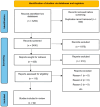Exploring the Role of Epithelial-Mesenchymal Transcriptional Factors Involved in Hematological Malignancy and Solid Tumors: A Systematic Review
- PMID: 39941895
- PMCID: PMC11817253
- DOI: 10.3390/cancers17030529
Exploring the Role of Epithelial-Mesenchymal Transcriptional Factors Involved in Hematological Malignancy and Solid Tumors: A Systematic Review
Abstract
Background: The epithelial mesenchymal transition (EMT) is a biological process in which epithelial cells lose their polarity and adhesion characteristics, and adopt a mesenchymal phenotype. While the EMT naturally occurs during tissue fibrosis, wound healing, and embryonic development, it can be exploited by cancer cells and is strongly associated with cancer stem cell formation, tissue invasiveness, apoptosis, and therapy resistance. Transcription factors (TFs) such as SNAIL, ZEB, and TWIST play a pivotal role in driving the EMT. This systematic review aims to assess the impact of EMT-TFs on hematological malignancy and solid tumors.
Methods: English-language literature published between 2010 and 2024 was systematically reviewed, utilizing databases such as PubMed and Google Scholar.
Results: A total of 3250 studies were extracted. Of these, 92 publications meeting the inclusion criteria were analyzed to elucidate the role of EMT-TFs in cancer. The results demonstrated that the EMT-TFs play a critical role in both hematological and solid tumor development and progression. They promote invasive, migratory, and metastatic properties in these tumors, and contribute to therapeutic challenges by enhancing chemoresistance. A strong correlation between EMT-TFs and poor overall survival has been identified.
Conclusions: Our research concluded that EMT-TFs may serve as important predictive and prognostic factors, as well as potential therapeutic targets to mitigate cancer progression.
Keywords: cancer progression; epithelial–mesenchymal transcriptional factors; epithelial–mesenchymal transition; hematological malignancy; solid tumor.
Conflict of interest statement
The authors declare no conflicts of interest.
Figures
References
-
- Zhang X., Yang L., Liu S., Cao L.L., Wang N., Li H.C., Ji J.F. Interpretation on the report of global cancer statistics 2022. Zhonghua Zhong Liu Za Zhi. 2024;46:710–721. - PubMed
Publication types
LinkOut - more resources
Full Text Sources
Research Materials





